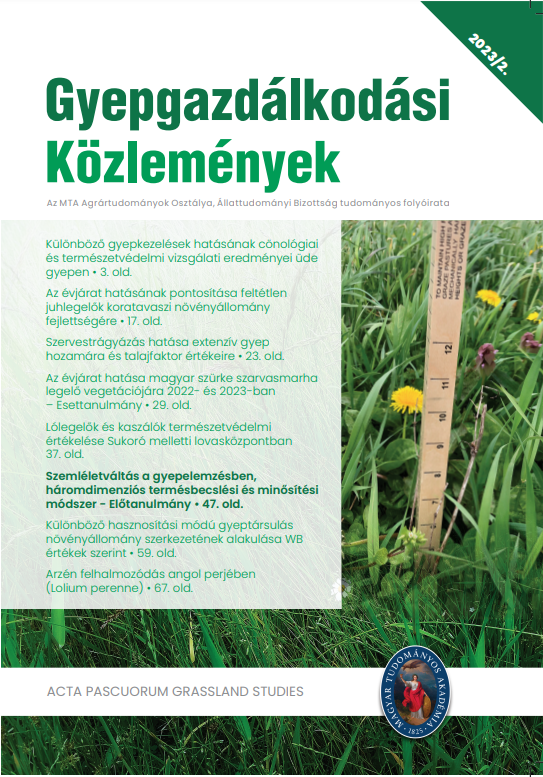Different agrotechnical mesures on the ecology and conservation in a wet meadow
Authors
View
Keywords
License
Copyright (c) 2024 Grassland Studies

This work is licensed under a Creative Commons Attribution-NonCommercial-NoDerivatives 4.0 International License.
How To Cite
Abstract
In grassland management systems, the various agrotechnical elements have to be used in many cases on "primitive grasslands", where the coordination of agricultural and nature conservation tasks is necessary. Here, animal husbandry is the main aspect, which includes the long-term preservation of the quality of the pasture, as well as the most economical use of the pasture and keeping the animals as cheap as possible. The tests were carried out on a grassy area on the border of the settlement of Aba. We examined the vegetation of 8 plots of the same size in the area and the quantitative and qualitative composition of the biomass produced there. In this thesis, we provide data on the vegetation composition and evaluation of the following treatments. The plots and treatments were as follows: I. plot-ventilated; II. parcel-relaxed; III. plot loosened and ventilated; ARC. parcel control; V. plot-ventilated and 15 t/ha manure; VI. plot loosened and 15 t/ha manure; VII. plot loosened, ventilated and 15 t/ha manure; VIII. plot loosened, ventilated and 30 t/ha manure. In each plot, 5 ceenological recordings were made using 4 x 4 m quadrats. The estimated coverage of each species was given in %, taking into account the proportion of grasslands and other species. Among Borhidi's plant ecological indicators, the species were evaluated based on the NB (relative values of nitrogen demand) and WB (relative soil water and soil moisture indicator numbers). The social behavior types (SZMT) were also defined based on Borhidi's work, and the nature conservation value categories (TVK) were defined according to Simon. The lifestyle analysis was performed based on Pignatti's lifestyle types.
Based on the data, the composition of the vegetation of each plot changed significantly compared to the data of the control plot IV. A direct proportionality can be discovered between the increase in the cover value of the dominant lawn grasses, primarily Festuca arundinacea, Dactylis glomerata, Alopecurus pratensis, and Fabaeceae species (e.g. Lathyrus tuberosus, Lotus corniculatus) and the amount of applied nutrients. Based on the coenological survey of the eight examined areas, the control area (IV.) showed the most natural state, which was confirmed by the species composition and number of species. The IV. plots are close to I., II. and III. for plot recordings, which proves that aeration and loosening do not worsen the condition of the lawn, but rather promote the preservation of its natural state. The VII-VIII. plots have the smallest number of species, but based on the life form spectrum, naturalness indicators, nature conservation value categories and social behavior types, they are not very disturbed habitats.
No significant difference can be detected between the effect of lawn loosening and lawn aeration, but III. plot, where both treatments were carried out, was closer to the control area. Regarding the effect of the lawn management methods, it was possible to produce a starting data set in the long term (with the same environmental conditions). Overall, the study gave valuable results regarding the age of change occurring during the application of different lawn management methods, and was also effective from an economic point of view.

 https://doi.org/10.55725/gygk/2023/21/2/13467
https://doi.org/10.55725/gygk/2023/21/2/13467